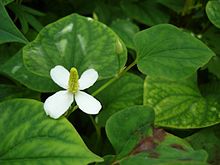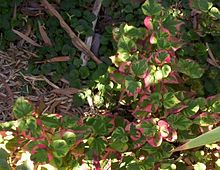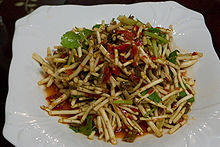- Houttuynia cordata
-
Houttuynia cordata 
Scientific classification Kingdom: Plantae (unranked): Angiosperms (unranked): Magnoliids Order: Piperales Family: Saururaceae Genus: Houttuynia
Thunb.Species: H. cordata Binomial name Houttuynia cordata
Thunb.Houttuynia cordata (simplified Chinese: 鱼腥草; traditional Chinese: 魚腥草; pinyin: yúxīng cǎo; literally "fishy-smell herb"; Vietnamese: giấp cá; pak kao tong (ຜັກຄາວທອງ) in Lao; Korean: 약모밀; English lizard tail and chameleon plant; Japanese: 十薬 or どくだみ), In English, it is known as Lizard tail, chameleon plant, heartleaf, fishwort and Bishop's weed.[1] It is one of two species in the genus Houttuynia, is a flowering plant native to Japan, Korea, southern China and Southeast Asia, where it grows in moist, shady places.
Contents
Growth
Houttuynia cordata is a herbaceous perennial plant growing to between 20 and 80 cm. The proximal part of the stem is trailing and produces adventitious roots, while the distal part of the stem grows vertically. The leaves are alternate, broadly heart-shaped, 4–9 cm long and 3–8 cm broad. Flowers, growing usually in Summer, are greenish-yellow, borne on a terminal spike 2–3 cm long with 4-6 large white basal bracts.
Cultivation
The plant grows well in moist to wet soil and even slightly submerged in water in partial or full sun. Plants can become invasive in gardens and difficult to eradicate. Propagation is via division.
In temperate gardens, it is usually in one of its cultivated forms, including: Chameleon (synonymous with H.c. 'Court Jester', H.c. 'Tricolour', H.c. 'Variegata') this variety is slightly less vigorous than the species and has leaves broadly edged in yellow and flecked with red; Flore Pleno has masses of white bracts and the vigour of the parent species.
Usage
Culinary use
Grown as a leaf vegetable, particularly in Vietnam, where it is called giấp cá or diếp cá and is used as a fresh herbal garnish. The leaf has an unusual taste that is often described as fishy (earning it the nickname "fish mint"), so it is not enjoyed as universally as basil, mint, or other more commonly used herbs.
In the southwestern Chinese provinces of Yunnan, Guizhou, and Sichuan, roots are used as a root vegetable. English names include heartleaf, lizardtail, and fishwort.
Traditional use
Houttuynia cordata is also used in used in folk medicine for diuresis and detoxification and herbal medicine for its antiviral, antibacterial and antileukemic activities.[2][not in citation given] Recently it has been suggested that it might have anti-obesity properties.[3] Houttuynia cordata was used by Chinese scientists to tackle SARS as it is conventionally used to treat pneumonia.[4]
H. cordata injection, a traditional Chinese medicine, is often used to relieve abnormal lung symptoms, infectious disease, refractory hemoptysis and malignant pleural effusion in China.[citation needed] H. cordata injection has a direct inhibitory activity against Pseudorabies herpes virus in vitro.[5]
Vap Ca is a very popular tonic herb in Japan and is used as a tonic tea, but also for chronic earache.[citation needed] The beverage dokudami cha (Japanese: ドクダミ茶; literally "Houttuynia cordata tea") is an infusion made from the leaves, Oolong tea leaves, and Job's Tears.[6][dead link]
It is used in traditional Chinese medicine and can cause severe allergic reactions.[7]
Aroma profile
Chemical compounds that contribute to the aroma of Houttuynia cordata include β-myrcene[8][9] and 2-undecanone.[10]
Invasive weed
Heartleaf or Lizard Tail is an alien invasive species in many areas in the United States and Australia.[11] Even the less vigorous forms will spread beyond an apt gardener's control if planted in any moderately moist soil.
Compendial status
- Japanese Pharmacopoeia [12][clarification needed]
Notes and references
- ^ http://www.our-vegetable-garden.com/houttuynia-cordata.htm
- ^ Houttuynia cordata Thunb extract inhibits cell growth and induces apoptosis in human primary colorectal cancer cells. Lai KC. Chiu YJ. Tang YJ. Lin KL. Chiang JH. Jiang YL. Jen HF. Kuo YH. Agamaya S. Chung JG. Yang JS. Anticancer Research. 30(9):3549-56, 2010 Sep. [Journal Article. Research Support, Non-U.S. Gov't] UI: 20944136
- ^ Water extract of Houttuynia cordata Thunb. leaves exerts anti-obesity effects by inhibiting fatty acid and glycerol absorption. Miyata M. Koyama T. Yazawa K. Journal of Nutritional Science & Vitaminology. 56(2):150-6, 2010. [Journal Article. Research Support, Non-U.S. Gov't] UI: 20495298
- ^ Immunomodulatory and anti-SARS activities of Houttuynia cordata. Lau KM. Lee KM. Koon CM. Cheung CS. Lau CP. Ho HM. Lee MY. Au SW. Cheng CH. Lau CB. Tsui SK. Wan DC. Waye MM. Wong KB. Wong CK. Lam CW. Leung PC. Fung KP. Journal of Ethnopharmacology. 118(1):79-85, 2008 Jun 19. [Journal Article. Research Support, Non-U.S. Gov't] UI: 18479853
- ^ Ren, X; Sui, X; Yin, J (2011). "The effect of Houttuynia cordata injection on pseudorabies herpesvirus (PrV) infection in vitro". Pharmaceutical biology 49 (2): 161–6. doi:10.3109/13880209.2010.505242. PMID 20942608.
- ^ "Beverage". KATAGIRI & CO.INC.. http://www.katagiri.com/ctlg/le.html. Retrieved 2006-10-04.
- ^ http://www.ycwb.com/ycwb/2006-09/19/content_1219074.htm (Chinese)
- ^ Lu, Hongmei et al.; Wu, Xianjin; Liang, Yizeng; Zhang, Jian (2006). "Variation in Chemical Composition and Antibacterial Activities of Essential Oils from Two Species of Houttuynia Thunb". Chemical & Pharmaceutical Bulletin 54 (7): 936–940. doi:10.1248/cpb.54.936. PMID 16819207. http://www.jstage.jst.go.jp/article/cpb/54/7/936/_pdf. Retrieved 31 March 2010.
- ^ Ch, Muhammad Ishtiaq et al.; Wen, YF; Cheng, Y (2007). "Gas Chromatographic/Mass Spectrometric Analysis of the Essential Oil of Houttuynia cordata Thunb by Using On-Column Methylation with Tetramethylammonium Acetate". Journal of AOAC International 90 (1): 60–67. PMID 17373437. http://www.jstage.jst.go.jp/article/cpb/54/7/936/_pdf. Retrieved 31 March 2010.
- ^ Liang, Minmin et al.; Qi, M; Zhang, C; Zhou, S; Fu, R; Huang, J (2005). "Gas chromatography–mass spectrometry analysis of volatile compounds from Houttuynia cordata Thunb after extraction by solid-phase microextraction, flash evaporation and steam distillation". Analytica Chimica Acta 531 (1): 97–104. doi:10.1016/j.aca.2004.09.082.
- ^ Global Invasive Species Database: Houttuynia cordata, accessed 2008-07-06
- ^ "JP 15". 2006. http://jpdb.nihs.go.jp/jp15e/JP15.pdf. Retrieved 31 March 2010.
See also
External links
- Flora of China: Houttuynia
- Asian Vegetables (with photo)
- Flora, The Gardener's Bible, ABC Publishing, Ultimo, NSW, Australia, 2006 ISBN 0 7333 1439 2
Categories:- Saururaceae
- Leaf vegetables
- Medicinal plants
- Korean ingredients
- Vietnamese ingredients
- Plants used in Traditional Chinese medicine
Wikimedia Foundation. 2010.


